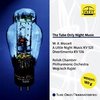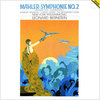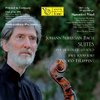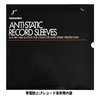SORRY - SOLD OUT
Tacet - L10 - 180 Gram Virgin Vinyl - AAA 100% Analogue - Limited Edition
Audiophile Mastering - Pressed at Pallas Germany
AAA 100% Analogue This LP was Remastered using Pure Analogue Components Only, from the Master Tapes through to the Cutting Head
Add to that the immediacy and vibrancy of the recording, cut at an unusually high level, and you have a dramatic and vivid sonic presentation that places the instrument right in front of you, enclosed in its own acoustic. Shut your eyes and you are there.5/5 Audiobeat
When it comes to Bach's Partitas for solo violin, many listeners would probably feel no need to reach any further in their collection other than for classic recordings by Grumiaux, Heifetz or Milstein. And although this offering from Tacet probably won't unshelve any of the masters based on absolute artistic values, it does, nonetheless, offer very compelling performances of the Partitas, all captured on superb 180-gram vinyl. Violinist Florin Paul acquits himself admirably throughout.
A number of excellent recordings have appeared on the Tacet label, but most of the recent buzz revolving around them has dealt with either their often unusual approach to recording music for surround sound, where individual instruments are assigned to specific channels — or, as in this particular recording, where classic tube microphones are employed in the session. This disc, whose recording session dates from 1989, uses two Neumann U47 tube microphones to spectacular effect — and offers a truly sumptuous string tone, along with an incredibly palpable recreation of the 1689 Stradivari violin employed here. Tacet has chosen in the multichannel mix to simply augment the sound with the rear channels to create more of a sense of ambience; while the effect is quite subtle, it does indeed achieve the desired goal of more of a sense of envelopment and preservation of the recorded acoustic. Stereo listeners won't be disappointed, though — Tacet is one of the handful of companies that seem quite competent at delivering superb ambience and acoustical cues from just a couple of well-placed microphones. Very highly recommended — this disc is such a delight to listen to, that its playing time passes all too quickly! - LP Magazine
Formerly concertmaster of Sergiu Celibidache’s Munich Philharmonic Orchestra, today Florin Paul occupies the same position with Hamburg’s North German Radio Symphony Orchestra. Some years ago he travelled to a small and rather unattractive church in the south of France, which was blessed with heavenly acoustics. With a precious, loaned Stradivari, he performed a silky and delicate yet crystal-clear Bach which Andreas Spreer captured using dust-free Neumann tube microphones. Thanks to the church’s slight resonance, an aura of consummate polyphony with lingering harmonies is created when the music ebbs away. With Bach’s Partitas sounding like this, it is irrelevant who the soloist was in days gone by. How fortunate we are to be able to enjoy such glorious sounds today!
Bach’s Sonatas and Partitas for Solo Violin (three of each) are one of the true monuments in the classical repertoire. Part exercise, part exploration, they were started in 1703, completed in 1720, but not published until 1802. Even then, they were largely ignored until they were taken up and championed by Joseph Joachim in the latter part of that century. Yet, despite this slow start, they have come to be recognized as one of the prototypical stages in classical development, a key test of any violinist’s technique. It’s a status that means we’re not exactly short of recordings, with most of the great violinists having a stab. You can take your pick from Perlman, Podger, Grumiaux, Szeryng, Milstein and any number of PYT wannabes. In the used-record bins, you could look out for Shumsky, while Testament offered the full set on three LPs from Ida Haendel -- although this is sadly now only available on CD.
With so many options out there, you might well wonder why we need another -- especially one that dates from 23 years ago. The answer lies in the approach taken to the recording, the justification in the nature of the recorded work. Tacet produce their recordings, even today, from an all-tube recording chain, from microphone through to analog tape recorder. This particular recording was made using a pair of vintage Neumann U47 mikes, capturing the virtuoso Florin Paul at the start of his distinguished career. Small-scale works lend themselves to such minimalist miking techniques and you don’t get much smaller in scale than a solo violin. But it is the combination of such a nimble musical voice with a composition of such resonance and massive emotional range that creates the enduring fascination in these pieces. The six works that constitute the whole encompass so much similarity yet differ so markedly that the scope for individual interpretation is almost unlimited. The beauty of Bach’s masterpiece lies in the solid structure, the security of a final destination, combined with the sheer flexibility that affords the individual traveler.
This disc contains just two of the partitas, Nos. 2 and 3, but you could argue that they’re the best of a stellar grouping. Florin Paul is captured in a church acoustic, playing an early Stradivarius with youthful gusto and musical abandon. Even by the standards of sonatas and partitas recordings, this is an intensely personal and individual reading. Add to that the immediacy and vibrancy of the recording, cut at an unusually high level, and you have a dramatic and vivid sonic presentation that places the instrument right in front of you, enclosed in its own acoustic. Shut your eyes and you are there.
So, no issues at all with the sonic performance. What about the artistic merits? For almost a decade, my go-to recordings of these works have been the Testament LPs [SBTLP 3090] and Julia Fischer on PentaTone SACD [5186 072]. Bizarrely, all three of these renditions need have no qualms about their audiophile credibility -- and all three deliver the sonic goods. But artistically speaking, they are worlds apart. Haendel was recorded at Abbey Road in 1995, well towards the end of her career. The perspective is slightly more distant, the instrument lacking the immediacy and power of the Tacet recording, but this is a mature performance that fully embraces the emotional power and range in the music. By the time the tapes rolled on this, Haendel had been playing at least part of these works for 60 years, and the depth of feeling and understanding makes that clear. What a contrast to the precocious talent of Julia Fischer, who made her PentaTone recording at the age of 21! As she wryly observes, there are those who would consider that presumptuous, but fear not. Fischer’s flawless technique and control carry the day, effortlessly unraveling the intricate musical puzzle and teasing out the flowing melodic lines that give the music its lasting appeal. PentaTone provide their usual clean, unfussy sound, and the church acoustic provides another parallel with the Tacet disc.
At 31, Florin Paul had a decade of performing experience over Fischer, yet hers is by far the more considered and controlled rendition. While part of that is surely down to temperament, it also reflects the two musicians’ instrument of choice. The Stradivarius is prized for the power of its voice, its ability to project, rather than the sheer beauty of its tone. Fischer’s Guadagnini dates from some 60 years later and has a far smoother, more delicate tonality, a quality she certainly makes the most of. Likewise, Paul’s dramatic, almost angular playing accentuates dynamic contrasts that are reinforced by the sheer energy coming off his instrument. Musically, at least for me, it’s a style that works better in the faster passages than the more measured ones, where the poise and control of Fischer wins out. But once the pace picks up there’s an infectious verve and excitement to Paul’s edge-of-the-seat performance.
No assessment of a sonatas and partitas recording can avoid the legendary Chaconne (Ciaconna) that closes the Second Partita. This 15+-minute exploration is the piece that you’ll hear most often as a standalone performance, a work that achieves almost shattering emotional intensity. Whilst neither Fischer nor Paul can match the performance of Haendel -- at least in emotional terms -- the breathtaking technical prowess of Fischer and the musical power and excitement generated by Paul render this an honorable draw.
Having listened to both partitas several times from all three players in the course of this review, I settled down for a direct comparison of that musical and emotional climax, listening to each reading in turn. And then I listened to them all again -- just for the pure pleasure of doing so. Which kind of tells you all you need to know. If you are buying just one recording, I’d go with the PentaTone, simply because it’s the best roadmap for the works. But once you’ve found your way around, I’d be putting both Haedel and Florin Paul on your list -- and if you want the music on LP, then it’s Paul that you’ll be listening to.
This might not seem like an obvious issue for an audiophile label, but the recording's purity of purpose and the commitment in the performance see it through. As Tacet note, they made the recording 23 years ago; if they made it today they’d doubtless do some things differently -- and Paul would certainly play the pieces differently. But then that’s the beauty of classical music: even the oldest works are living, breathing things that never stop evolving. Haendel, Fischer and now Paul -- what it is to be spoilt for choice
Roy Gregory
Inspiring Tube Sound:
What is it that makes "tube sound" what it is? The advantages of tubes over transistors are difficult to describe in technical terms. Perhaps the reference to the higher and different type of distortion with tube amplifiers is most applicable, although "distortion" has a rather negative meaning: the more distortion, the worse it is. So this can't be entirely right. Besides, the distortions of these microphones of 1947 are much too slight to be really noticeable. The recording of the Partitas of Johann Sebastian Bach with Florin Paul is, for me, although meanwhile almost 23 years old, still the best example in our TACET catalogue of the special quality of tube microphones. The two U 47 microphones by Neumann made their contribution.
For the LP, however, (except for rare exceptions, justified for musical reasons) the signal is even stored on a tube tape recorder and then mastered with valve equipment, so that one would be right in saying that for the entire production not a single transistor was used.
We have always been especially pleased to receive so much feedback about our Tube Only productions. This motivates us even more to keep working with this technology and rescue it from oblivion. People have told us that the music sounds warmer, without losing any of its TACET brilliance. The timbres glow more. We have also heard that people have the impression of a more homogeneous sound, whatever that is meant to be. So let everyone listen to their own hearts and to the Tube Only recordings and feel something special! Even the sheer joy of this slightly nostalgic outstanding technology can be reason enough to like these productions. Yet what would it all be without the wonderful work of the artists!
Recorded 1989 in Falicon, Nice, France by Andreas Spreer.
Musicians:
Florin Paul, violin
Selections:
Johann Sebastian Bach (1685-1750)
Side A:
Partita I B minor
1. Allemanda
2. Double
3. Corrente
4. Double-Presto
5. Sarabande
6. Double
7. Tempo di Borea
8. Double
Side B:
Partita II D minor
1. Allemanda
2. Corrente
3. Sarabande
4. Giga
5. Ciaconna
PALLAS
Audiophile Vinyl - Made in Germany For over 60 years the family business in the third generation of the special personal service and quality "Made by Pallas" is known worldwide. Our custom PVC formulation produces consistently high pressing quality with the lowest surface noise in the industry. Our PVC complies with 2015 European environmental standards and does not contain toxic materials such as Lead, Cadmium or Toluene. Our vinyl is both audiophile and eco-grade!















